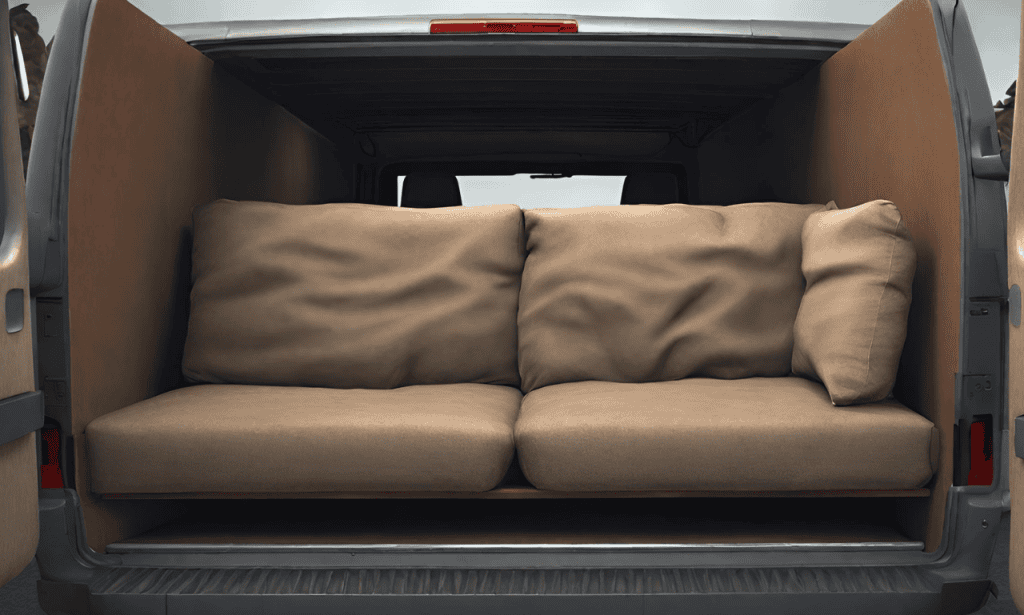Can a Couch Fit in a Cargo Van? Everything You Need to Know

Are you moving and wondering if your couch will fit in a cargo van? Or are you thinking about buying a new couch but not sure how you’re going to get it home? The good news is that most couches will fit in a cargo van.
A cargo van is a commercial van that is designed to transport goods and materials. Cargo vans are typically larger than passenger vans and have a higher payload capacity. They are also more likely to have features such as a bulkhead or cargo divider, which can help to secure cargo in place. Cargo vans come in a variety of sizes, from small vans such as the Ford Transit Connect to large vans such as the Mercedes-Benz Sprinter. The size of the cargo van you need will depend on the amount of cargo you need to transport.
Couches also come in a variety of sizes, from small loveseats to large sectional sofas. The size of the couch you have will also determine whether or not it will fit in a cargo van.
Cargo Van & It’s Sizes
Moving a couch is a big job, and the cargo van you pick is a big part of that. You need a van that can handle your couch’s size and weight.
Cargo Van
Size: Average cargo space of about 230 to 400 cubic feet.
A basic cargo van usually gives you all you need to move a couch. These vans come with a large empty area in the back, no seats, nothing fancy. It’s a straightforward choice. You drive to the rental place, show your ID, pay some money, and the van is yours for the day. Easy.
Fuel efficiency in cargo vans is usually okay, not great but not terrible either. You should also consider the height of the loading area. Some cargo vans have low roofs, so check that out. Make sure you can stand upright if you’re tall, or it’ll be hard to move stuff around.
Also, check the door. Open it and see how wide it is. You need a door that’s wider than the widest part of your couch. If your couch is 80 inches wide, you want a door that’s at least 85 inches wide, to make your life easier.
Passenger Van with Removed Seats
Size: About 216 to 252 cubic feet after removing seats.
If you can’t get a cargo van, a passenger van is your next best choice. They have seats, but you can remove them to make space. After you take out the seats, it’s almost like a cargo van inside, just with more windows. More windows mean better visibility when you’re driving, which is always a good thing.
Before you choose this van, measure it like you would a cargo van. Check the doors, check the height, and look at the floor. Sometimes the floor has hooks or spots where the seats were bolted down. Make sure these won’t be in your way when you’re moving the couch.
Box Truck
Size: Around 960 cubic feet or more.
The box truck is the big one. This truck gives you a lot of space, like, a lot. But for a single couch, it might be too much. You could fit like four couches in there, maybe more. It’s the go-to vehicle if you’re moving a whole house, not just one piece of furniture.
Box trucks are different to drive than vans. They’re much bigger, heavier, and not as easy to park. They also eat up more gas. But the space is huge, like a small room on wheels. Also, remember to check the door sizes here too. Even though the truck is big, the door might not be.
Door Dimensions
Door size is a big deal. Let’s say you have a van with a door that’s 60 inches high and 50 inches wide. Your couch measures 40 inches high and 80 inches long. These numbers need to match for the move to work. Pay attention to any door handles or protrusions; these could mess up the fit.
The dimensions can differ between the side and back doors of the van. Take a Ford Transit as an example. The back door opens up to 62 inches high and 60 inches wide. It’s crucial to know these numbers beforehand because your couch needs to fit through these dimensions. A 40-inch high, 80-inch long couch would fit in a Ford Transit without any issues.
The same measuring rule applies to the doors at home. Say your home door is only 30 inches wide, but your couch is 40 inches wide. That’s a clear problem. The couch won’t fit through the door. So, always make sure to measure the doors at your home as well. This way, the move goes off without any hitches or nasty surprises.
Manpower for Loading
Need more than one guy to lift a couch, that’s for sure. Best to get maybe two, or three more people. Heavy stuff, couches. No solo action here unless you’re looking for back pain. So call friends, family, get them on board.
Lifting right matters too. Always use your legs, not your back. The whole crew’s got to move in sync. Count— one, two, three, then lift, just like that. Keep the movement smooth. No jerky motions. Make sure everyone is on the same page. Talking while lifting helps. Shout commands like “Left a bit,” “hold,” or “Down now,” stuff like that.
You’ll want someone to watch out for any obstacles. Could be steps you didn’t notice or lamps hanging low. Have one person just guiding, not doing the heavy lifting. They keep their eyes open and guide the lifting crew, helping avoid bumps and other issues. Less hassle, less chance of something going wrong.
Best Ways to Position the Couch
No one likes a scratched or torn-up couch, right? So, things like moving blankets or plastic wrap come in super handy.
Wrap it Up
First things first, wrapping the couch well. Plastic wrap is your friend. It keeps the fabric clean and stops any sudden rips or stains. Wrap it around tight but not too tight. You don’t want to crush the cushions.
Blanket Cover
Moving blankets offer extra padding. Lay them over the couch, especially the corners and edges. Those are the parts that usually get hit or scraped. Tuck in the blankets and secure them with some rope or tape.
Lift and Slide
Don’t drag the couch into the van. Lift it up and then slide it in. Less chance of wrecking the bottom that way. Also, this way, you don’t mess up the van floor.
Upright or Flat
Depending on the van size, you might put the couch in upright or lay it flat. Upright takes less floor space but might wobble. Flat is more stable but takes up more room.
Lock and Load
Last step, secure the couch. Use ropes or bungee cords. Attach them to the van’s hooks or rails. Make sure the couch won’t move around when you’re driving.
Measure the couch and the van first. Those numbers have to match, or you’re stuck. Size of the van’s door and home doors, don’t overlook those. Next, round up some people. Lifting a couch is a team sport, no solo heroes here. Wrap that couch up nice and tight in plastic or moving blankets to dodge any scuffs or damage.


